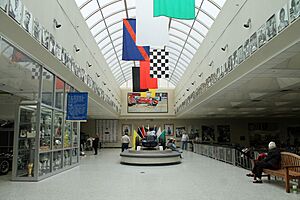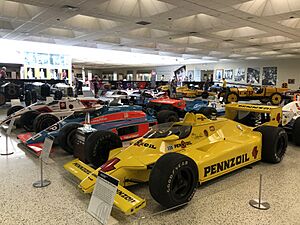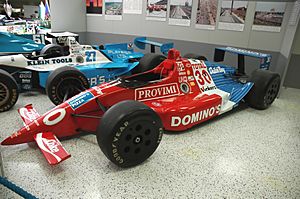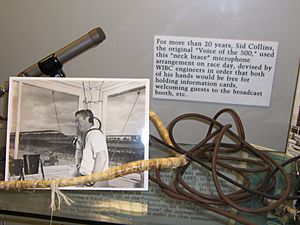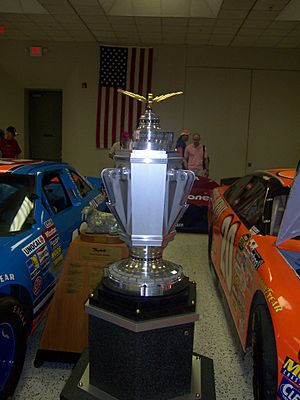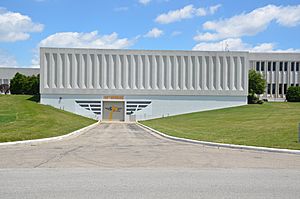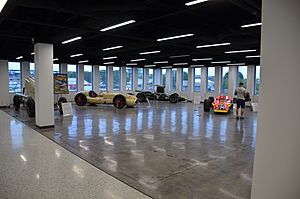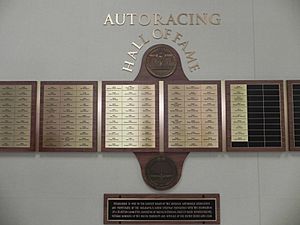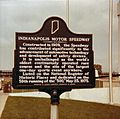Indianapolis Motor Speedway Museum facts for kids
 |
|
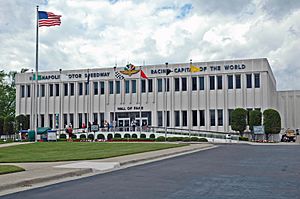
Indianapolis Motor Speedway Museum in 2005
|
|
| Lua error in Module:Location_map at line 420: attempt to index field 'wikibase' (a nil value). | |
| Former name | Indianapolis Motor Speedway Hall of Fame Museum |
|---|---|
| Established | April 7, 1956 |
| Location | 4750 West 16th Street Indianapolis, Indiana 46222 |
| Type | Automotive |
| Visitors | 1 million (2019) |
The Indianapolis Motor Speedway Museum is a cool place to visit if you love cars and racing! It's located right at the famous Indianapolis Motor Speedway in Speedway, Indiana. This museum is home to the Indianapolis Motor Speedway Hall of Fame. It's mostly about the exciting Indianapolis 500 and Brickyard 400 races. But it also shows off other types of motorsports, regular passenger cars, and the history of cars in general. The museum celebrated its 50th birthday in 2006. You can see many cars that won the Indianapolis 500 here. They also display special pace cars. The cars on display change regularly, so there's always something new to see!
The Indianapolis Motor Speedway Foundation, a non-profit group, owns and runs the museum. The museum first opened in 1956. It moved into its current building in 1976. You can find it inside the race track itself. The museum is open all year, except on holidays like Thanksgiving and Christmas. In November 2023, the museum closed for a big update. It reopened on April 2, 2025, after an $89 million renovation project.
Contents
History of the Museum
The very first museum at the Indianapolis Motor Speedway opened on April 7, 1956. This first building was on the southwest side of the property. When it first opened, it only had six cars. One of them was Ray Harroun's car that won the 1911 Indianapolis 500. Soon, many more collector cars were given to the museum. It quickly ran out of space! By 1961, about 5,000 people visited the museum each week. This number didn't even include the huge crowds during May, when the Indy 500 race happens.
In 1975, work began on a new, much larger museum. This new building was inside the track's infield. It was about 96,000 square feet. Besides the museum, this two-story building also held the Speedway's offices, ticket office, and a gift shop. The bigger museum opened on April 5, 1976. It was called the Hall of Fame Museum. The first museum building was then used for extra offices.
The Indianapolis Motor Speedway itself became a historic place in 1975. It was named a National Historic Landmark in 1987. You can see a special plaque about this at the museum.
In 1993, the original museum building was taken down. A new office building was built in its place. The Speedway's offices moved out of the infield museum building. This made more room for the museum's gift shop.
The museum parking lot hosted the first "Indy 500 Expo" in 1993. This was an outdoor event for fans during race time. It grew and was renamed "Indy 500 FanFest" in 1995. It stopped after 1997. But in recent years, smaller displays have shown old pace cars.
In 2016, the museum started a project to make it more modern. They wanted to add more display space. In April 2016, the museum's name officially changed to the Indianapolis Motor Speedway Museum. Its goal became to honor achievements and contributions to the Speedway. The museum closed for major updates in late 2023. It officially reopened on April 2, 2025. The updates added seven permanent galleries and three rotating ones. There's also a new area for non-car items. Plus, new interactive displays, like a pit stop challenge, let visitors pretend to change a race car tire!
What You Can See: Exhibits
The museum usually has about 75 cars on display. The main display area is about 37,500 square feet. This means only a small part of the museum's huge collection can be shown at one time. Often, cars are loaned out to other museums or car shows.
The collection includes over thirty cars that won the Indianapolis 500. There are also many other Indy cars and race cars from different types of racing. You can also see pace cars and regular passenger cars. Many of these cars were made in Indiana. Other items on display include trophies, plaques, and racing gear. This includes helmets, gloves, and driver suits. The museum also has changing exhibits. These might feature model cars, photos, toys, or paintings. Displays also highlight the history of the Speedway's owners and how the track has changed.
Indianapolis 500 Winning Cars
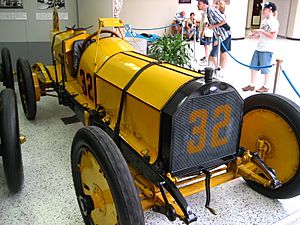
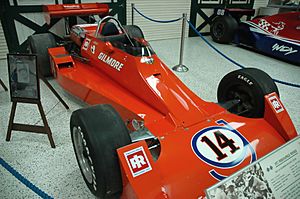
Here are some of the famous Indianapolis 500 winning cars you might see:
- 1911 Marmon Wasp (the first Indy 500 winner) (Ray Harroun)
- 1912 National (Joe Dawson)
- 1914 Delage (Rene Thomas)
- 1922 Duesenberg (Jimmy Murphy)
- 1925/1927 Duesenberg (Peter DePaolo in 1925, George Souders in 1927)
- 1928 Miller (Louis Meyer)
- 1939–1940 Boyle Special Maserati (won two years in a row) (Wilbur Shaw)
- 1947–1948 Blue Crown Spark Plug Special (won two years in a row) (Mauri Rose)
- 1953–1954 Fuel Injection Offy (won two years in a row) (Bill Vukovich)
- 1957–1958 Belond Special Offy (won two years in a row) (Sam Hanks in 1957; Jimmy Bryan in 1958)
- 1961 Bowes Seal Fast Offy (A. J. Foyt)
- 1964 Sheraton-Thompson Watson Offy (A. J. Foyt)
- 1967 Sheraton-Thompson Coyote Foyt (A. J. Foyt)
- 1977 Gilmore Racing Team Coyote/Foyt (A. J. Foyt)
- 1990 Domino's Pizza Hot One Lola/Chevrolet (Arie Luyendyk)
- 1995 Player's Ltd. Reynard/Ford Cosworth BX (Jacques Villeneuve)
Other Cool Race Cars
- 1912 Fiat driven by Teddy Tetzlaff (finished second)
- 1931 Cummins Diesel driven by Dave Evans (first car to finish the Indy 500 without a pit stop!)
- 1961 Cooper Climax driven by Jack Brabham (one of the first rear-engined cars from Europe)
- 1977 Bryant Heating & Cooling Lightning/Offy driven by Janet Guthrie (the first woman to qualify for the Indy 500)
- 2005 Panoz/Honda driven by Danica Patrick (the first woman to lead a lap in the Indy 500)
Passenger Cars and Other Vehicles
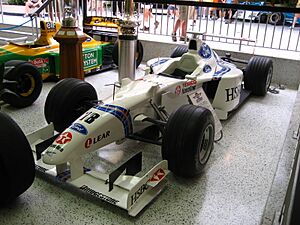
The museum also displays:
- Many Indy 500 pace cars from different years.
- Early cars like an 1886 Daimler "Motor Carriage" and an 1886 Benz Patent Motorwagen.
- A NASCAR stock car driven by Richard Petty.
- A sprint car driven by A. J. Foyt.
- A 1998 Stewart SF02-Ford Formula One car.
- The 1965 Le Mans-winning Ferrari 250 LM.
- The 1965 Spirit of America – Sonic 1 Land Speed Record car.
Trophies and Special Displays
The museum is the permanent home for some very important trophies:
- The Borg-Warner Trophy, given to every Indy 500 winner.
- The Wheeler-Schebler Trophy, an older trophy from before the Borg-Warner.
- The PPG trophy, given to the winner of the Brickyard 400.
- A display of historic trophies and medals from many races.
Other exhibits include:
- Paintings and photographs by famous artists.
- An exhibit about the Indianapolis Motor Speedway Radio Network, with old radio equipment.
- The Tony Hulman theatre, where you can watch a short film about the race's history.
- You can also take a bus tour of the track for an extra fee.
Special Exhibits and Hidden Gems
The museum often has one or two special exhibits each year. These focus on different themes or famous racers.
- 2016: Team Penske 50th Anniversary and Tony Stewart exhibits.
- 2017: A. J. Foyt exhibit (celebrating his fourth Indy 500 win).
- 2018: "The Amazing Unsers" (celebrating the famous Unser racing family).
- 2019: Mario Andretti exhibit ("Mario Andretti: Icon").
- 2021: Rick Mears exhibit ("Rocket Rick Mears").
- 2022: "Roadsters 2 Records" (about front-engine Indy roadsters from the 1960s).
Before the 2023–2025 renovations, a large part of the museum's collection was stored away. These areas were usually not open to the public. But after the museum reopened in 2025, visitors can now see the basement storage area! This means you can see even more rare vehicles.
In 2016, the museum added 7,500 square feet of display space. This new area is called the North Hall. It shows more cars and offers a view of part of the Speedway road course.
Indianapolis Motor Speedway Hall of Fame
The Indianapolis Motor Speedway Hall of Fame started in 1952. It was first called the Auto Racing Hall of Fame. Tony Hulman, who bought the Speedway in 1945, wanted to create a hall of fame. As of 2024, 165 people have been honored in the hall.
The Hall of Fame stopped for a few years after 1955. But in 1961, Tony Hulman brought it back. He made it part of the Speedway museum.
To be nominated, a person must have been involved in professional auto racing for at least twenty years. Drivers don't have to be retired to be considered. A group of about 150 people votes for new members. This group includes racing officials, current hall of fame members, historians, and media. In 2018, the Hall of Fame's focus became wider. It now includes people who participated in all major races at the Speedway. This means the Indianapolis 500, Brickyard 400, U.S. Grand Prix, and major motorcycle races. Jeff Gordon was the first driver honored mainly for his wins in a race other than the Indy 500.
Voting happens every year. New members are usually announced in the spring. They are officially honored in May, just before the Indianapolis 500 race. The number of new members changes each year. In 2025, Hélio Castroneves was inducted into the Hall of Fame.
Here are some symbols you might see next to names:
- (W) — Means they won the Indianapolis 500 as a driver.
- (O) — Means they won the Indianapolis 500 as an owner.
- (BY) — Means they won the Brickyard 400 as a driver.
- (BYO) — Means they won the Brickyard 400 as an owner.
- (GP) — Means they won the U.S.G.P. as a driver.
Hall of Fame Drivers
- Mario Andretti (W)
- Billy Arnold (W)
- Tony Bettenhausen
- Jack Brabham
- Jimmy Bryan (W)
- Hélio Castroneves (W)
- Gaston Chevrolet (W)
- Jim Clark (W)
- Bill Cummings (W)
- Joe Dawson (W)
- Ralph DePalma (W)
- Pete DePaolo (W, O)
- Mark Donohue (W)
- Dale Earnhardt Sr. (BY)
- Emerson Fittipaldi (W)
- Pat Flaherty (W)
- A. J. Foyt (W, O)
- Fred Frame (W)
- Dario Franchitti (W)
- Jeff Gordon (BY)
- Jules Goux (W)
- Janet Guthrie
- Sam Hanks (W)
- Ray Harroun (W)
- Graham Hill (W)
- Bill Holland (W)
- Ted Horn
- Gordon Johncock (W)
- Parnelli Jones (W, O)
- Ray Keech (W)
- Tony Kanaan (W)
- Frank Lockhart (W)
- Arie Luyendyk (W)
- Rick Mears (W)
- Louis Meyer (W, O)
- Tommy Milton (W)
- Juan Pablo Montoya (W)
- Jimmy Murphy (W, O)
- Johnnie Parsons (W)
- Bobby Rahal (W, O)
- Jim Rathmann (W)
- Dario Resta (W)
- Floyd Roberts (W)
- Mauri Rose (W)
- Johnny Rutherford (W)
- Troy Ruttman (W)
- Michael Schumacher (GP)
- Wilbur Shaw (W, O)
- Tom Sneva (W)
- Tony Stewart (BY, BYO)
- Danny Sullivan (W)
- Bob Sweikert (W)
- Al Unser (W)
- Al Unser Jr. (W)
- Bobby Unser (W)
- Bill Vukovich (W)
- Lee Wallard (W)
- Rodger Ward (W)
- Dan Wheldon (W)
- Howdy Wilcox (W)
Hall of Fame Owners, Mechanics, and Contributors
- J. C. Agajanian (O)
- James A. Allison
- George Bignotti (O)
- Thomas W. Binford
- Colin Chapman (O)
- Louis Chevrolet (O)
- Tim Cindric
- Sid Collins
- Donald Davidson
- August Duesenberg
- Fred Duesenberg
- Chris Economaki
- Carl G. Fisher
- Henry Ford
- Mari Hulman George
- Tony George
- Chip Ganassi (O, BYO)
- Andy Granatelli (O)
- Dan Gurney (O)
- Harry Hartz (O)
- Lindsey Hopkins
- Mary Fendrich Hulman
- Anton "Tony" Hulman
- Bob Jenkins
- Frank Kurtis (O)
- Harry Miller
- Lou Moore (O)
- Fred Offenhauser
- Paul Page
- U.E. "Pat" Patrick (O)
- Roger Penske (O, BYO)
- George Robertson
- George Salih (O)
- Bill Simpson
- Harry C. Stutz
- William K. Vanderbilt
- A. J. Watson
- John Zink
Images for kids
-
A replica of Mario Andretti's Brawner Hawk, the 1969 Indy 500 winner
See Also
- List of automobile museums
- List of museums in Indiana
- List of attractions and events in Indianapolis
- Louis Chevrolet Memorial (a statue outside the museum)


